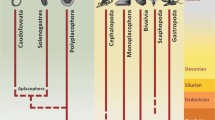Abstract
The molecular species composition was determined for phosphatidylcholine (PC) isolated from the marine dinoflagellateCrypthecodinium cohnii grown at three different temperatures. At all three temperatures the didocosahexaenoyl species comprised about 25% of the PC with 14∶0/22∶6 and 16∶0/22∶6 also being of major importance; these three species comprised 75–82% of the total. Another 20 species were identified, including several short chain disaturated species. Only small differences in the composition of PC were found in response to growth at 16, 23 and 27°C. On dropping the growth temperature from 27°C to 16°C the largest changes were a decrease of 8.9% in saturated/saturated species and an increase of 5.3% in saturated/PUFA species; the 22∶6/22∶6 content only increased slightly (by 1.9% to 25.4%). This unusual molecular species composition is discussed.
Similar content being viewed by others
Abbreviations
- BHT:
-
butylated hydroxytoluene
- HPLC:
-
high performance liquid chromatography
- HPTLC:
-
high performance thin-layer chromatography
- PC:
-
phosphatidylcholine
- PE:
-
phosphatidylethanolamine
- PS:
-
phosphatidylserine
- PUFA:
-
polyunsaturated fatty acid
- TLC:
-
thin-layer chromatography
- molecular species:
-
e.g., 14∶0/22∶6, 1-myristoyl-2-docosahexaenoyl-sn-glycero-3-phosphocholine
References
Harrington, G.W., and Holz, G.G. (1968)Biochim. Biophys. Acta 164, 137–139.
Beach, D.H., and Holz, G.G. (1973)Biochim. Biophys. Acta 316, 56–65.
Henderson, R.J., Leftley, J.W., and Sargent, J.R. (1988)Phytochemistry 27, 1679–1683.
Tuttle, R.C., and Loeblich, A.R. (1975)Phycologia 14, 1–8.
Folch, J., Lees, M., and Sloane Stanley, G.H. (1957)J. Biol. Chem. 226, 497–509.
Vitiello, F., and Zanetta, J.-P. (1978)J. Chromatogr. 166, 637–640.
Parsons, J.G., and Patton, S. (1967)J. Lipid Res. 8, 696–698.
Takamura, H., Narita, H., Urade, R., and Kito, M. (1986)Lipids 21, 356–361.
Bell, M.V. (1989)Lipids 24, 585–588.
Takahashi, K., Hirano, T., Takama, K., and Zama, K. (1982)Bull. Japan. Soc. Sci. Fish. 48, 1803–1814.
Robinson, M., Blank, M.L., and Snyder, F. (1986)Arch. Biochem. Biophys. 250, 271–279.
Blank, M.L., Cress, E.A., Robinson, M., and Snyder, F. (1985)Biochim. Biophys. Acta 833, 366–371.
Aveldano, M.I., and Bazan, N.G. (1983)J. Lipid Res. 24, 620–627.
Bell, M.V., and Tocher, D.R. (1989)Biochem. J. 264, 909–915.
Heinz, E. (1977) inLipids and Lipid Polymers in Higher Plants, pp. 102–120, Springer-Verlag, Berlin and New York.
Tocher, D.r., and Harvie, D.G. (1988)Fish Physiol. Biochem. 5, 229–239.
Applegate, K.R., and Glomset, J.A. (1986)J. Lipid Res. 27, 658–680.
Hazel, J.R., and Landrey, S.R. (1988)Am. J. Physiol. 255, R628-R634.
Harel, Z., and Djerassi, C. (1980)Lipids 15, 694–696.
Author information
Authors and Affiliations
About this article
Cite this article
Bell, M.V., Henderson, R.J. Molecular species composition of phosphatidylcholine fromCrypthecodinium cohnii in relation to growth temperature. Lipids 25, 115–118 (1990). https://doi.org/10.1007/BF02562215
Received:
Accepted:
Issue Date:
DOI: https://doi.org/10.1007/BF02562215




